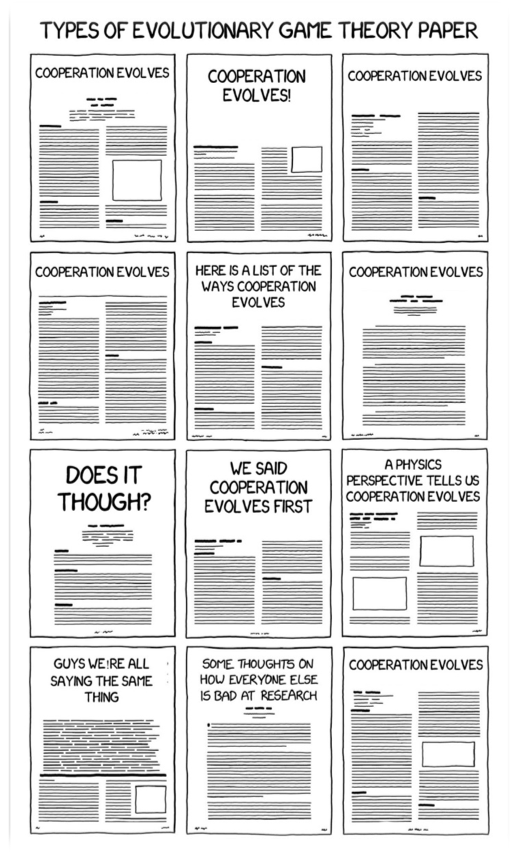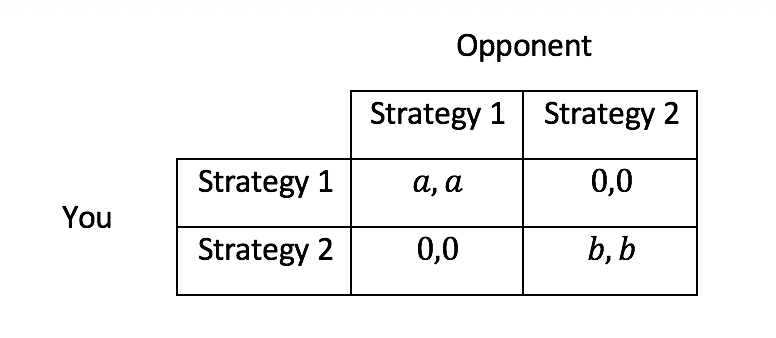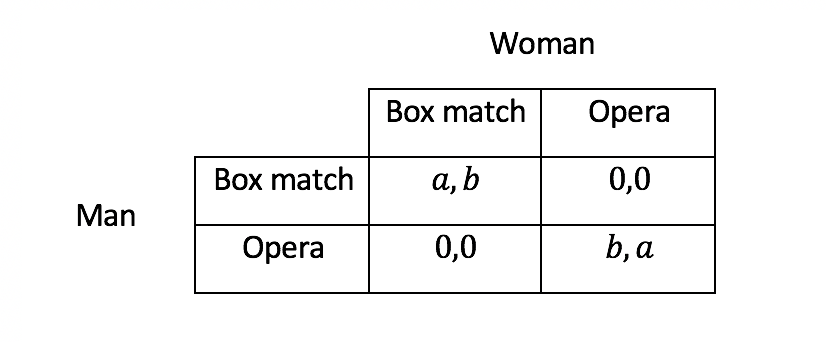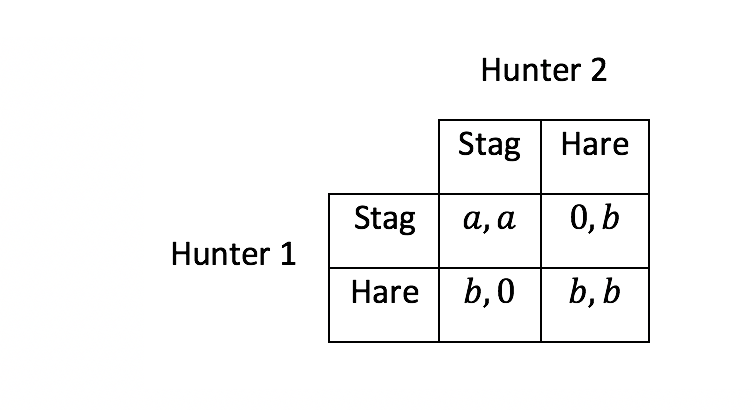Why we should use coordination games in cancer
Original Perspective
Coordination games in cancer
Péter Bayer, Robert A. Gatenby, Patricia H. McDonald, Derek R. Duckett, Kateřina Staňková, Joel S. Brown
Read the preprint
What are coordination games?
Coordination games describe situations that offer rewards for conformity. Individuals playing coordination games realize high payoffs if they all choose the same strategy and lower payoffs if some individuals deviate. Variants of coordination games exist for the many possible payoff structures that specify the different rewards of achieving coordination on each strategy, the punishment that deviators receive, and how the conformists are hurt by the deviators. The most stringent type of coordination game is called pure coordination game, in which players receive a payoff a>0 if they coordinate on Strategy 1, b>0 if they coordinate on Strategy 2, and 0 if they fail to coordinate. If a>b, we may imagine this as a model of adopting a new technology: players can realize the highest payoffs by agreeing to use the more efficient Strategy 1 or lower payoffs by sticking with the less efficient Strategy 2, but if they fail to coordinate, chaos ensues, leaving them with zero payoffs. If a=b, the game is called choosing sides: it doesn’t matter which strategy ends up winning as long as the players agree. We can imagine this as a model of which side of the road to drive on: for the purposes of traffic efficiency, what we agree on doesn’t make a difference, only that we agree.
Table 1: The pure coordination game with two players. The first value is the payoff of the row player (You), the second is the payoff of column player (Opponent).
Arguably the most famous variant is the battle of the sexes. The classic story is that a couple plans to go out together, the man would prefer to go to see a box match, the woman would prefer to go to the opera. Both of them would like to be together so even their less preferred outcome is superior to going to different events.
Table 2: The battle of the sexes (a>b>0).
Another cool variant is called the stag hunt. The story is that two hunters decide on which animal to hunt, Stag or Hare. The Stag can only be hunted through a collective effort, while a less valuable Hare can be hunted down individually. A hunter playing Hare is guaranteed a payoff of b, but if both play Stag, they can receive the higher payoff a>b. However, if the players cannot agree on Stag, anyone who tried to play it receives a payoff of 0.
Table 3: . The stag hunt game with two players
As we’ve seen, coordination games come in many flavors and can be applied in many situations. The common theme is the drive to conformity: it is never worth it to deviate from the strategy played by the other player. Importantly for the applied setting, an in particular, cancer research, deviators decrease not only their own payoff, but also those of non-deviators.Why are coordination games understudied?
Cancer is a relatively new application of game theory, so I think to measure whether the extent by which coordination games are understudied it is better to turn to a more established application. I chose the application in law as Richard McAdams’s article titled ‘Beyond the prisoner’s dilemma’ gives a very comprehensive overview. McAdams states that (as of January 2009) there were 3119 articles in law mentioning the PD game, against 246 mentions of the coordination game (this includes the variants such as 123 mentions of the stag hunt game, 76 of the battle of the sexes, and 102 mentions of the Hawk/Dove game which are not coordination games but anti-coordination games, an important distinction in an evolutionary setting but not so much in the non-cooperative setting that is relevant for law), so coordination games mentions to roughly 8% of the PD mentions. What’s worse is that many of the PD mentions even misidentify games that are in fact coordination games as PD games. Not only are coordination games underrepresented, even when they are represented, people fail to recognize them. So why is this? I think the main reason is that the stories of coordination games are not as evocative as some other games, particularly the PD/PG game. Even at their best, coordination games appear to be trivial and mundane. At their worst, they are downright boring. In PD/PG the simple choice between cooperation and defection is intertwined with behavioral characteristics and social constructs: altruism, selfishness, pro-sociality, free-riding, trust, punishment, social success through collaboration, or failure through division. They invite researchers to identify a method (or a zillion methods) of intervention to push from the “rational” outcome of all players defecting to the desired outcome of all players cooperating. All of this is absent in coordination games. The stag hunt variant offers something to work with as it is a choice between a “safe” and a “risky” strategy and the payoff dominant equilibrium is socially optimal, but there is not much to go on in the barest of variants, the choosing sides game. There, the only question is whether the players agree, and which equilibrium arises is completely immaterial from an individual or a social perspective. So, it is no wonder that the rawest form of the coordination game, and the most important research question surrounding them which is, “how can we come to an agreement?” gets ignored. The second reason is that coordination games are obscure. Once an equilibrium is reached – and the incentive structure is such that an equilibrium will indeed be reached eventually – the winning strategy is fixated, while the losing strategy goes extinct. The game is, in appearance, over, and unless one knows to look for them, the losing strategies cannot be observed (at least not within the same population). Once we reach a decision on which side of the road we drive on, which animal we hunt, or which sex we favor the game’s result disguises itself as a general wisdom, common practice, natural or human law, or a universal truth. Even worse, in these games it is downright detrimental for the whole of society for even one player to digress from the norm, so experimenting with a deviant strategy or as little as revealing the game can be socially unrewarding. The third, somewhat technical reason is that coordination games don’t have very interesting dynamics. Researchers tend to be drawn to captivating problems and the dynamics induced by coordination games are simply outshone by those of other games. Instead of a beautiful dance of strategies like in the RPS game, there is a single move to the nearest equilibrium, and then it is game over. That’s not to say that no one is doing cool things with coordination games; let me point to Yang, Basanta, and Piliouras (2018) who might be the first to use an actual coordination games model in a cancer application, I only mean to say that finding cool phenomena to research tends and requires more creative work, while getting it published and recognized requires greater presentation skills than other game classes.What makes coordination games interesting for cancer research?
Perhaps the most important reason why coordination games in cancer should be researched is that, as we point out in our Supplementary Information, the conditions for coordination games to arise in cell-cell interactions are quite mild. With the myriads of possible cell-cell interactions that affect cancer there are bound to be ones that are best modeled using coordination games. If we keep focusing our attention on interactions that can be modeled through familiar classes of games, we blind ourselves to valuable insights. What makes coordination games stand out in particular even among other understudied game classes is that uncovering them also uncovers weaknesses in an eco-evolutionary system. If the population, in our case, the tumor of cancer cells fails to coordinate, or if failure to coordinate can be effectuated, its fitness is lowered, perhaps, to the point where extinction of the tumor is possible. Conversely to the last point, coordination games also uncover the points where an eco-evolutionary system is most resilient. Unless a permanent change can be achieved in the underlying game, the population will rebound once it returns to being coordinated, and remember, the incentive structure is such that it will return, so treatments do well to address this. The population may even rebound through achieving coordination on a different strategy possibly with unforeseen consequences to the patient’s prognosis. Finally, to address the issue of coordination games not being interesting enough: The many unique aspects of cancer progression and treatment introduce such a rich variety of changes into the model that I don’t think there is an upper bound on the number and quality of interesting dynamics even when the underlying game itself is not a flashy one. I would argue that given the richness that will necessarily be added to a cancer model, it is actually very useful to start with a model that, on its own, has predictable dynamic properties.Conclusion
In our paper we propose a model of coordination games in cancer, offer two candidate aspects of cancer that may be modeled through coordination games, and, through mathematical modeling and simulations, demonstrate a proof-of-concept of the ways through which they may be leveraged to improve therapy outcomes in cancer patients. On a broader level, our paper is an invitation for experimenters to look for coordination games in cancer, which ideally could lead to therapeutic strategy seeking to attack suspect driver-mutations. After all, if they indeed constitute a coordination game, stopping cancer from coordinating could wreak absolute havoc in the tumor’s ecosystem. For math modelers and evolutionary theorists, I hope our paper and this post serves to ignite interest in researching (evolutionary) coordination games. This class of games is relatively unknown but has great potential in mapping out the incentive structures of conformity. Whether the ‘goal’ of the research project is to understand, break, or preserve a system, uncovering its coordination games offers valuable insights into its resilience, fragility, its capacity to change, and the types of evolutionary strategies that go or don’t go well together. Link to paper. Link to supplementary information.References
- Yang, G., Basanta, D. and Piliouras, G., 2018. Bifurcation Mechanism Design—From Optimal Flat Taxes to Better Cancer Treatments. Games, 9(2), p.21.
- McAdams, R.H., 2009. Beyond the prisoners' dilemma: Coordination, game theory, and law. S. Cal. L. Rev., 82, p. 209.
© 2025 - The Mathematical Oncology Blog